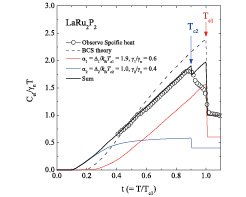Two-Band Gap Superconductivity in LaRu2P2
T. Fujiwara and Y. Uwatoko
The recent discovery of superconductivity iron arsenide family has lead to wide research activities in advanced solid state physics. So far, lots of iron arsenide intermetallics family have been synthesized and investigated their physical properties, especially, characteristics of their superconductivity since the recent discovery of superconductivity in LaFeAs(O,F) compound [1]. Both structure and symmetry of superconducting gap are often studied and argued to clarify the origin of their superconductivity with significantly high superconducting transition temperature in various kinds of Fe-As based compounds.

Fig. 1. The normalized superconducting electronic specific heat (Cel/γnT) of LaRu2P2 as a function of scaled temperature t = T/Tc1. The dased line represents the theoretical curve based on single-band weak-coupling BCS theory. Red and blue solid lines represent the numerically calculated curves of contributions from two gaps and the summation of those contributions are given by black solid line.
We paid our attention on ternary phosphide LaRu2P2 which is one of related material of iron arsenides superconductors crystallize in the ThCr2Si2 type structure. This compound shows a superconductivity below Tc ~ 4.4 K [2] and an upper critical fields Hc2 vary isotropically with increasing or/and decreasing temperature. In addition, LaRu2P2 single crystal obtained in this work exhibits remarkably larger Hc2 than that expected from GL theory at considerably low temperature, suggesting that this system is not conventional type II superconductor. So, we investigated a calorimetric characteristics in ternary phosphide LaRu2P2 in this work.
Temperature dependence of the electronic specific heat Cel/γnT of LaRu2P2 is shown in Figure 1. As drown by open symbol represents the experimental data, we can see two clear discontinuities of specific heat at Tc1 = 4.4 K and Tc2 = 4.0 K, respectively. Each transition temperature vary obeying Hc2(t) = Hc2(0)(1-t2)/(1+t2), where, t = T/Tc1. This indicates that both discontinuities at Tc1 and Tc2 are attributed to superconducting transitions. We tried to analyze our specific heat data by α model [4]. In this model, zero temperature scaled gap α = ∆(0)/kBTc is the only adjustable fitting parameter. In the case of two gaps, the thermodynamic properties of the system are determined as the sum of contributions from the two gaps with individual transition temperatures, that is, α1 = ∆1(0)/kBTc1 and α2 = ∆2(0)/kBTc2 with their respective weights γ1/γn and γ2/γn, where γ1+γ2 = γn. In Fig.1, numerically calculated C(T) curves are shown together with observed data. Red and blue solid lines represent contributions from each gap to C(T) estimated by adapting α1=1.9 (∆1(0) = 0.72 meV) and α2 = 1.0 (∆2(0) = 0.34 meV), respectively. Black solid line represents the summation of both contributions and dashed line is the theoretical Curve based on single-band weak-coupling BCS theory with the ∆(0)/kBTc1 = 1.76. The former line well reproduces experimental result over the entire measurement temperature range, indicating that LaRu2P2 is the superconductor characterized by two band gaps as well as BaFe2As2 based compounds. In addition, N2 is larger than N1, where N1 and N2 are DOS at EF in respective bands. Unfortunately, it is unapparent that how Ru 4d electrons do contribute to these bands at present.To understand the main band occupies the Fermi level, it is required to be studied the detailed electronic structure of LaRu2P2.
References
- [1] Y. Kamihara, T. Watanabe, M. Hirano, and H. Hosono, J. Am. Chem. Soc. 130, 3296 (2008).
- [2] T. Fujiwara, K. Matsubyashi, Y. Uwatoko, and T. Shigeoka, J. Phys.: Conf. Ser. 273, 012112 (2011).
- [3] J. J. Ying, Y. J. Yan, R. H. Liu, X. F. Wang, A. F. Wang, M. Zhang, Z. J. Xiang, and X. H. Chen, Supercond. Sci. Technol. 23, 115009 (2010).
- [4] H. Padamsee. J. E. Neighbor, and A. C. Shiffman, J. Low Temp. Phys. 12, 387 (1973).
